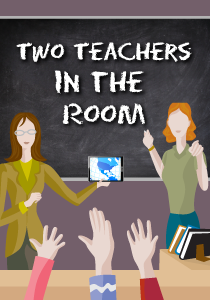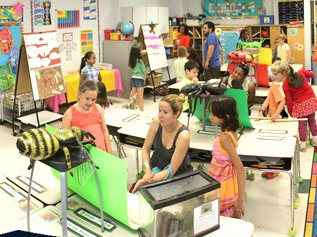Co-Teaching Insights: A Voice From the Field
A MiddleWeb Blog
 Since writing my last post, Elevating co-teaching through social media, I have reflected further on the power of my online learning. I thought about my many valuable connections that not only serve to deepen my learning (and ultimately—my students!) but also allow me to share my thinking in ways that can support my virtual colleagues on their pedagogical journeys. It’s a win-win experience that results in an endless cycle of rejuvenation!
Since writing my last post, Elevating co-teaching through social media, I have reflected further on the power of my online learning. I thought about my many valuable connections that not only serve to deepen my learning (and ultimately—my students!) but also allow me to share my thinking in ways that can support my virtual colleagues on their pedagogical journeys. It’s a win-win experience that results in an endless cycle of rejuvenation!
This week’s post comes from an interview that I recently did with Barbara Flanagan for a Pepper professional development course, School-wide Inclusive Practices. Learn more about Pepper (which is a collaboration between WestEd and Public Consulting Group) at Pepper: A National Network of Common Core Specialists.
When Barbara Flanagan asked if I would be interested in being a “Voice From the Field” for one of her upcoming courses, I was beside myself with excitement! It became yet another amazing connection! Barbara and I were already following one another on Twitter, but it wasn’t until she reached out to me that our connection came to life. A great example of: it’s not the connections you make—but what you create from those connections!
Barbara is a Senior Associate at PCG Education, where she focuses on UniversalDesign for Learning (UDL) and its real-world application for meeting the needs of diverse learners. For those who wish to jump into a bit of deep reading—check out this white paper by Barbara Flanagan, Cheryl Liebling, and Julie Meltzer entitled Universal Design for Learning and the Common Core ELA Standards: Rigorous Reading and Writing Instruction for All. Be empowered–it’s quite a resource! Enjoy!
And now for the interview….

Elizabeth: Effective co-teaching is flexible, considerate, and inclusive. Both teachers consider the perspective of the other as they work in tandem to blend their beliefs, personalities, and teaching moves. There is a level of trust and respect that results in an unspoken give and take leading to a learning environment where both teachers are included in all phases of the lesson. Teachers speak with “we” language rather than “I” language.
Ideally, both teachers proactively plan to remove any potential barriers in the learning environment—and they are open minded during the moments of teaching to include on-the-spot accommodations and strategies that will guide students toward success within the moments of their instruction.
Both teachers remain open minded and find moments each day to briefly reflect on how lessons unfolded and how students responded to instruction. This quick check-in each day paves the way for smooth learning pathways the next day and beyond.
Barbara: You have a rich background in co-teaching. As you’ve co-taught throughout the years, what do you see as some of the benefits of co-teaching for teachers and students?
Elizabeth: General education teachers become more aware of the variability of learners in their classroom—and they become more sensitive as they learn how to address these diverse needs. Special education teachers deepen their content knowledge and are immersed in the rigor and high expectations of the general education curriculum. Both teachers expand their repertoire of teaching strategies and can really strengthen the power of their teaching moves. As each co-teacher shares his or her expertise, I think general education teachers strengthen their focus on the process (the why and how) of learning, while special education teachers can deepen their awareness of the content knowledge (the what) of learning experiences.
Barbara: Research suggests that co-teaching is only as good as the efforts put in place to set up a workable model. In your years of experience as a co-teaching partner…what do you believe are the “non-negotiables” that administrators must follow to set up and support co-teaching teams so that they are successful?
Elizabeth: There must be ongoing professional development and opportunities for co-teachers to meet with one another to discuss how things are going. They need time to share their perspective on student progress, lesson objectives, and instructional process. Co-teachers must discuss their perspectives on the roles and responsibilities for each co-teacher to ensure a smooth instructional process. Co-teachers need to have time to have those “this went well because….and next time we should….” kinds of conversations.

One of the professional development opportunities must inform all co-teachers about the various co-teaching models. Co-teachers must be expected to apply a variety of models over time.
Barbara: …what do you believe are the “non-negotiables” that co-teaching teams must have in place and follow in order for students to be successful?
Elizabeth: Both teachers’ perspective and expertise must be valued and incorporated into the learning moments. The worst thing that can happen is when one teacher (typically the general education teacher) takes full control of the entire lesson, while the other teacher (typically the special education teacher) walks quietly around the room to monitor students’ performance. There must be a balance of each teacher incorporating his or her expertise into the learning moments. Walking around the room to monitor student performance is part of the process, but it shouldn’t be the role of one teacher for the entire lesson.
Co-teachers must define the role and responsibilities of each teacher, so that the instructional process flows with smooth success brought about by the expertise of both teachers. All students benefit from having two teachers in the room when the implementation of teaching practices is meaningful, purposeful, and meets the varying needs of learners in the room.
Barbara: What advice would you give to co-teacher teams that were just starting to work together so that they get on the right track and pave the way for success for students?

Barbara: Even with the best collaborative and instructional practices, there are potentially a few students who need extra support to be successful, both in and outside the classroom setting. What successful structures and practices can co-teaching teams put in place to support those students who need additional assistance?
Elizabeth: Co-teachers should outline a consistent parent-teacher relationship at the beginning of the year. Both teachers should engage in ongoing communication with parents. It’s not good practice for the special education teacher to be the only teacher to communicate with parents of children who need additional supports; it should never become a “your students—my students” kind of mindset. It should always be about how are “we” going to support these students.
Within the classroom environment, the co-teachers should vary the implementation of the co-teaching models. For example, teachers can incorporate parallel teaching where the two teachers split the whole class into two groups. Each teacher teaches to one group, which would allow for all students to receive more individualized attention. This is good for all students and may be particularly beneficial for students who get lost in the whole class instruction.
Another model of co-teaching, station teaching, could allow teachers to implement instruction in even smaller groups. The whole class could rotate through four stations, for example. Each teacher is then free to facilitate learning as well as any necessary re-teaching needed for individual and small groups of students. The bottom line is that each teacher needs to be open-minded, flexible, and willing to communicate, so that all students will have the opportunity to succeed. Building in structural supports through varying the co-teaching models of instruction will go a long way in breaking down any instructional or learning barriers, so that all students will have access all materials and achieve their personal best.
Thank you, Barbara, for this amazing opportunity!
As for our readers, I hope you will share your thoughts. What are your responses to one or more of the meaningful questions Barbara asks? What are your thoughts about my responses?
I’m looking forward to our conversations!



































